Preparation of PANI/CuPc/PDMS Composite Elastomer with High Dielectric Constant and Low Modulus Assisted by Electric Fields
Abstract
:1. Introduction
2. Materials and Methods
2.1. Materials
2.2. Preparation of PANI/PDMS and CuPc/PDMS Two-Phase Composite Films
2.3. Preparation of PANI/CuPc/PDMS Three-Phase Composites
2.4. Characterization Methods
3. Results
3.1. Orientation Kinetics of PANI Particles and CuPc Particles under Electric Fields
3.1.1. Effect of Electric Field Intensity and Time on the Self-Assembly Process of PANI Particles
3.1.2. Effect of Electric Field Frequency on the Self-Assembly Process of PANI Particles
3.1.3. Characterization of the Effect of Electric Field on CuPc Particles
3.1.4. Orientation Process of PANI Particles and CuPc Particles under Electric Field
3.2. Characterization of PANI/PDMS and CuPc/PDMS Composite Films
3.2.1. Analysis of Cross-Section Morphology of PANI/PDMS Composite Film
3.2.2. Analysis of Dielectric Properties of PANI/PDMS Composite Films
3.2.3. Characterization of Cross-Section Morphology of CuPc/PDMS Composite Films
3.2.4. Analysis of Dielectric Properties of CuPc/PDMS Composite Films
3.3. PANI/CuPc/PDMS Three-Phase Composite Film
3.3.1. Characterization of the Cross-Section Morphology of PANI/CuPc/PDMS Composite Film
3.3.2. Analysis of Dielectric Properties and Electrical Conductivity of PANI/CuPc/PDMS Composite Films
3.3.3. Mechanical Property Analysis of PANI/CuPc/PDMS Composite Film
3.3.4. Analysis of Electro-Deformation Properties of PANI/CuPc/PDMS Composite Films
4. Conclusions
Author Contributions
Funding
Data Availability Statement
Conflicts of Interest
References
- Kousseff, C.J.; Wustoni, S.; Silva, R.K.S.; Lifer, A.; Savva, A.; Frey, G.L.; Inal, S.; Nielsen, C.B. Single-Component Electroactive Polymer Architectures for Non-Enzymatic Glucose Sensing. Adv. Sci. 2024, 33, 2308281. [Google Scholar] [CrossRef] [PubMed]
- Hahn, F.; Ferrandez-Montero, A.; Queri, M.; Vancaeyzeele, C.; Plesse, C.; Agniel, R.; Leroy-Dudal, J. Electroactive 4D Porous Scaffold Based on Conducting Polymer as a Responsive and Dynamic In Vitro Cell Culture Platform. ACS Appl. Mater. Interfaces 2024, 16, 5613–5626. [Google Scholar] [CrossRef]
- Cheng, S.; Tang, Y.; Gao, Q.; Wang, X.; Li, A.; Yuan, Y.; Guan, S. Biocompatible graphene/chitosan hybrid aerogel reinforced polydimethylsiloxane nanocomposite with excellent dielectric properties. J. Appl. Phys. 2023, 140, 53261. [Google Scholar] [CrossRef]
- Roh, H.; Yue, S.; Hu, H.; Chen, K.; Kulik, H.J.; Gumyusenge, A. Unraveling Polymer–Ion Interactions in Electrochromic Polymers for their Implementation in Organic Electrochemical Synaptic Devices. Adv. Funct. Mater. 2023, 33, 2304893. [Google Scholar] [CrossRef]
- Park, M.; Yoo, S.; Bae, Y.; Kim, S.; Jeon, M. Enhanced Stability and Driving Performance of GO–Ag-NW-based Ionic Electroactive Polymer Actuators with Triton X-100-PEDOT:PSS Nanofibrils. Polymers 2019, 11, 906. [Google Scholar] [CrossRef] [PubMed]
- Wang, H.; Yang, L. Dielectric constant, dielectric loss, conductivity, capacitance and model analysis of electronic electroactive polymers. Polym. Test. 2023, 120, 107965. [Google Scholar] [CrossRef]
- Kim, Y.; Yoshida, Y. A Lightweight and Low-Voltage-Operating Linear Actuator Based on the Electroactive Polymer Polypyrrole. Polymers 2023, 15, 3455. [Google Scholar] [CrossRef]
- Zhao, H.; Hussain, A.M.; Israr, A.; Vogt, D.M.; Duduta, M.; Clarke, D.R.; Wood, R.J. A Wearable Soft Haptic Communicator Based on Dielectric Elastomer Actuators. Soft Robot. 2020, 7, 451–461. [Google Scholar] [CrossRef]
- Shimizu, K.; Nagai, T.; Shintake, J. Dielectric Elastomer Fiber Actuators with Aqueous Electrode. Polymers 2021, 13, 4310. [Google Scholar] [CrossRef]
- Zhao, Z.; Chen, Y.; Hu, X.; Bao, R.; Wu, B.; Chen, W. Vibrations and waves in soft dielectric elastomer structures. Int. J. Mech. Sci. 2023, 239, 107885. [Google Scholar] [CrossRef]
- Liu, K.; Chen, S.; Chen, F.; Zhu, X. A Unidirectional Soft Dielectric Elastomer Actuator Enabled by Built-In Honeycomb Metastructures. Polymers 2020, 12, 619. [Google Scholar] [CrossRef] [PubMed]
- Rybak, A. Functional Polymer Composite with Core-Shell Ceramic Filler: II. Rheology, Thermal, Mechanical, and Dielectric Properties. Polymers 2021, 13, 2161. [Google Scholar] [CrossRef] [PubMed]
- Larguech, S.; Kreit, L.; Zyane, A.; Triki, A.; El Hasnaoui, M.; Achour, M.E.; Belfkira, A. Dielectric properties of microcrystalline cellulose/multi-wall carbon nanotubes multi-scale reinforced EVA/VeoVa terpolymer. J. Compos. Mater. 2022, 56, 3861–3880. [Google Scholar] [CrossRef]
- Manika, G.C.; Gioti, S.; Sanida, A.; Mathioudakis, G.N.; Abazi, A.; Speliotis, T.; Patsidis, A.C.; Psarras, G.C. Multifunctional Performance of Hybrid SrFe12O19/BaTiO3/Epoxy Resin Nanocomposites. Polymers 2022, 14, 4817. [Google Scholar] [CrossRef] [PubMed]
- Wu, W.; Ren, T.; Liu, X.; Huai, K.; Cui, X.; Wei, H.; Hu, J.; Xia, Y.; Huang, S.; Fu, K.; et al. Electric field-assisted preparation of PANI/TPU all-organic composites with enhanced dielectric permittivity and anisotropic optical properties. Polym. Eng. Sci. 2022, 62, 3945–3951. [Google Scholar] [CrossRef]
- Wang, Q.; Wu, W.; Che, J.; Chen, T.; Liu, X.; Huai, K.; Hu, J.; Jin, P.; Zhang, J.; Chen, Y. High dielectric PANI/PDMS all-organic composites fabricated by electric fields-assisted assembling. Polym. Bull. 2023, 80, 12417–12431. [Google Scholar] [CrossRef]
- Guo, Y.; Zhou, D.; Li, R.; Li, D.; Zhao, W.; Pang, L.; Shi, Z.; Liu, W.; Su, J.; Zhou, T.; et al. Novel relaxor ferroelectric BTWO nanofillers for improving the energy storage performance of polymer-based dielectric composites. J. Energy Storage 2024, 76, 109585. [Google Scholar] [CrossRef]
- Yuan, H.; Liu, Z.; Song, J.; Okamura, S.; Xin, J.H.; Xue, M.; Jing, T. Soft Gel Filler Embedded Elastomer with Surfactant Improved Interface for Dielectric Elastomer Actuators. ACS Appl. Mater. Interfaces 2024, 4, 4264. [Google Scholar] [CrossRef] [PubMed]
- Wu, W.; Ren, T.; Liu, X.; Davis, R.; Huai, K.; Cui, X.; Wei, H.; Hu, J.; Xia, Y.; Huang, S.; et al. Creating thermal conductive pathways in polymer matrix by directional assembly of synergistic fillers assisted by electric fields. Compos. Commun. 2022, 35, 101309. [Google Scholar] [CrossRef]
- Yang, L.; Wang, H.; Zhang, D.; Yang, Y.; Leng, D. Large deformation, high energy density dielectric elastomer actuators: Principles, factors, optimization, applications, and prospects. Chem. Eng. J. 2024, 489, 151402. [Google Scholar] [CrossRef]
- Tsyganov, A.; Vikulova, M.; Zotov, I.; Artyukhov, D.; Burmistrov, I.; Gorokhovsky, A.; Gorshkov, N. Significantly Enhanced Balance of Dielectric Properties of Polyvinylidene Difluoride Three-Phase Composites by Silver Deposited on K2Ni0.93Ti7.07O16 Hollandite Nanoparticles. Polymers 2024, 16, 223. [Google Scholar] [CrossRef]
- Zhang, H.; Zhang, S.; Zhou, S.; Huang, Z.-X.; Qu, J.-P. A novel mechanism of hybrid fillers on enhanced dielectric constant and suppressed dielectric loss in percolative nanocomposites. Polymer 2023, 283, 126244. [Google Scholar] [CrossRef]
- Chen, Y.; Liu, Y.; Xia, Y.; Liu, X.; Qiang, Z.; Yang, J.; Zhang, B.; Hu, Z.; Wang, Q.; Wu, W.; et al. Electric Field-Induced Assembly and Alignment of Silver-Coated Cellulose for Polymer Composite Films with Enhanced Dielectric Permittivity and Anisotropic Light Transmission. ACS Appl. Mater. Interfaces 2020, 12, 24242–24249. [Google Scholar] [CrossRef]
- Shen, G.; Yu, W.; Qiao, H.; Chen, D.; Wang, Y.; Li, M.; Zhang, Y.; Zhou, H. Measuring orientation dynamics of carbon fibers by dielectric anisotropy in shear flows. NDT E Int. 2022, 129, 102646. [Google Scholar] [CrossRef]
- Bai, X.; Peng, R.; Xing, H.; Xie, S.; Zhang, J.; Zhang, S.; Deng, X.; Li, X.; Peng, Y.; Zheng, X. Magnetic vortex configuration in Fe3O4 nanorings/nanotubes for aspect ratio and magnetic orientation regulated microwave absorption. Results Phys. 2024, 58, 107543. [Google Scholar] [CrossRef]
- Chen, T.; Wang, J.; Li, X.; Chen, Y.; Liu, S.; Liu, Z.; You, Q.; Liu, X.; Chen, F.; Liu, J. High dielectric transparent polymer composite with well-organized carboxymethyl cellulose microfibers in silicon elastomer fabricated under direct current electric field. Carbohydr. Polym. 2024, 329, 121803. [Google Scholar] [CrossRef]
- Qin, X.; Lu, W.; Wang, X.; Qin, Z.; Chen, H.; Lu, G.; Lu, G.; Bu, L. Surface-modified polydimethylsiloxane with soft-plasma as dielectric layer for flexible artificial synaptic transistors. Appl. Surf. Sci. 2023, 627, 157325. [Google Scholar] [CrossRef]
- Yu, Y.; Huang, B.; Zhao, Y.; Zhao, Y.; Dai, L.; Zhang, Z.; Fei, H.-F. Enhanced Dielectric Properties of Polydimethylsiloxane Elastomer-Based Composites with Cyanosilicone. ACS Appl. Polym. Mater. 2023, 5, 259–268. [Google Scholar] [CrossRef]
- Xu, W.; Yi, P.; Gao, J.; Deng, Y.; Peng, L.; Lai, X. Large-Area Stable Superhydrophobic Poly(dimethylsiloxane) Films Fabricated by Thermal Curing via a Chemically Etched Template. ACS Appl. Mater. Interfaces 2020, 12, 3042–3050. [Google Scholar] [CrossRef]
- Qin, H.; Feng, Y.; Liu, K.; Mi, J.; Zhang, L.; Tian, M. From Molecular-Scale Cavities to Nanoscale Dielectric Breakdown in Polydimethylsiloxane Induced by Local Electric Field. Macromolecules 2022, 55, 1690–1699. [Google Scholar] [CrossRef]
- Shen, L.; Wang, T.-P.; Goyal, S.; Lee, T.-H.; Lin, F.-Y.; Torres, S.; Robison, T.; Cochran, E.W. Easy-Processable and Aging-Free All-Polymer Polysiloxane Composites. ACS Appl. Polym. Mater. 2020, 2, 5835–5844. [Google Scholar] [CrossRef]
- Yang, Q.; Li, C.; Zhou, W.; Li, Y.; Zhu, Y.; Ma, Y. High-dielectric porous CaCu3Ti4O12/reduced graphene oxide/polydimethylsiloxane foam for wearable, breathable and low crosstalk capacitive pressure sensor. FlatChem 2023, 40, 100522. [Google Scholar] [CrossRef]
- Wang, H.; Zhao, H.; Zhang, C.; Zhang, N.; Gao, Y.; Wu, Y.; Miao, Z.; Bai, J. Improved electro-actuated property of polydimethylsiloxane-based dielectric elastomer by designing a Bi-network structure. Polymer 2024, 292, 126600. [Google Scholar] [CrossRef]
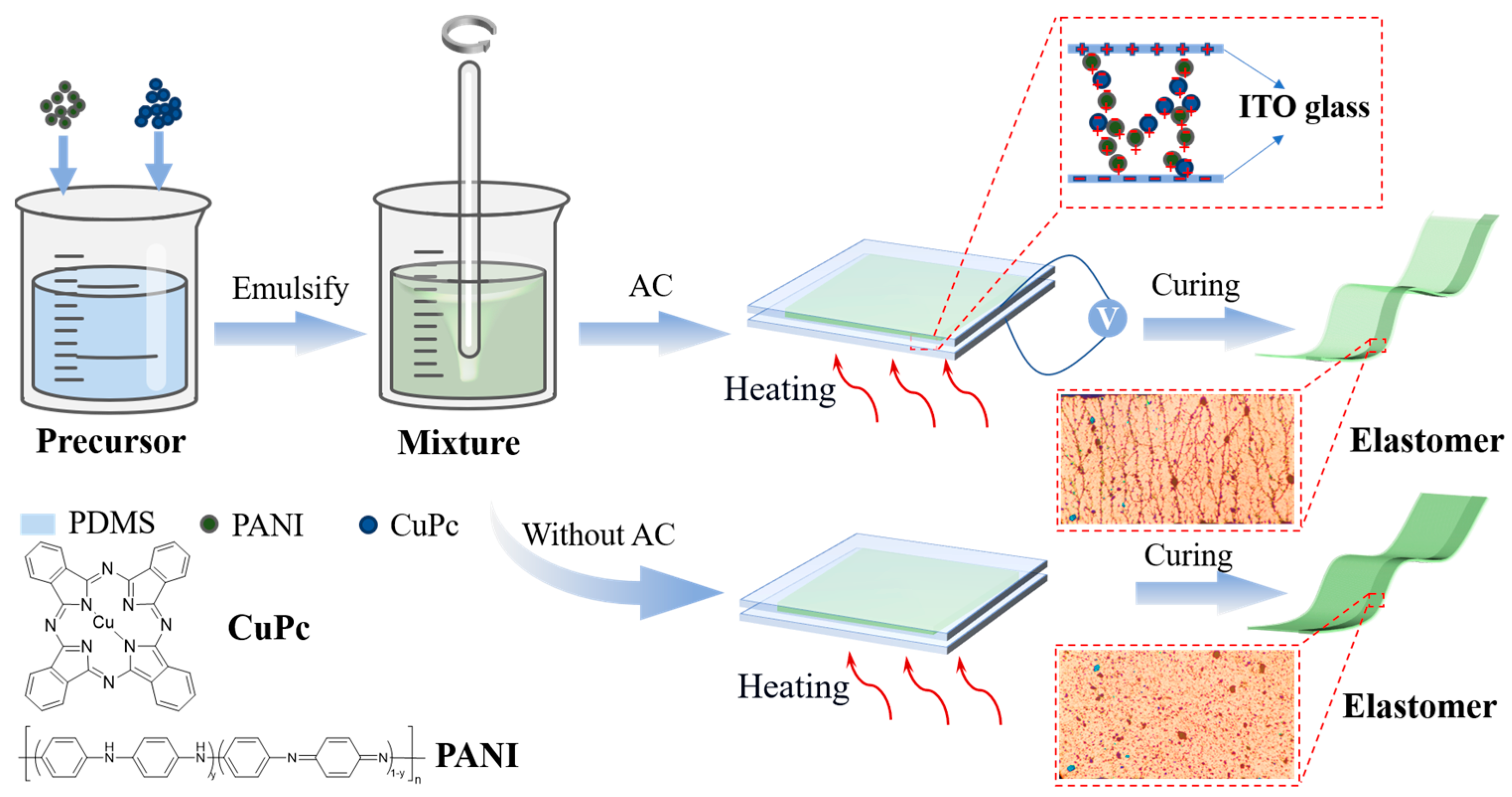

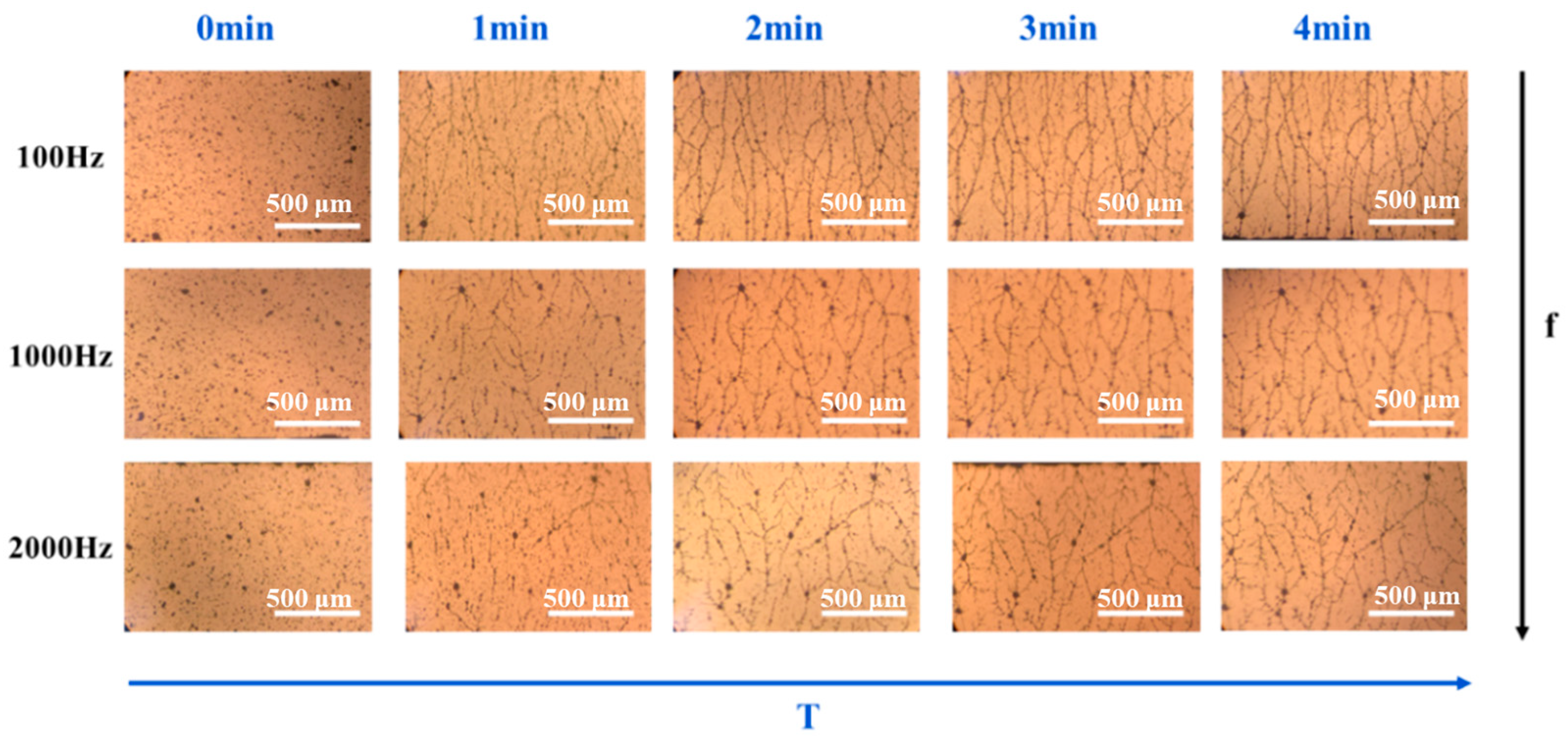

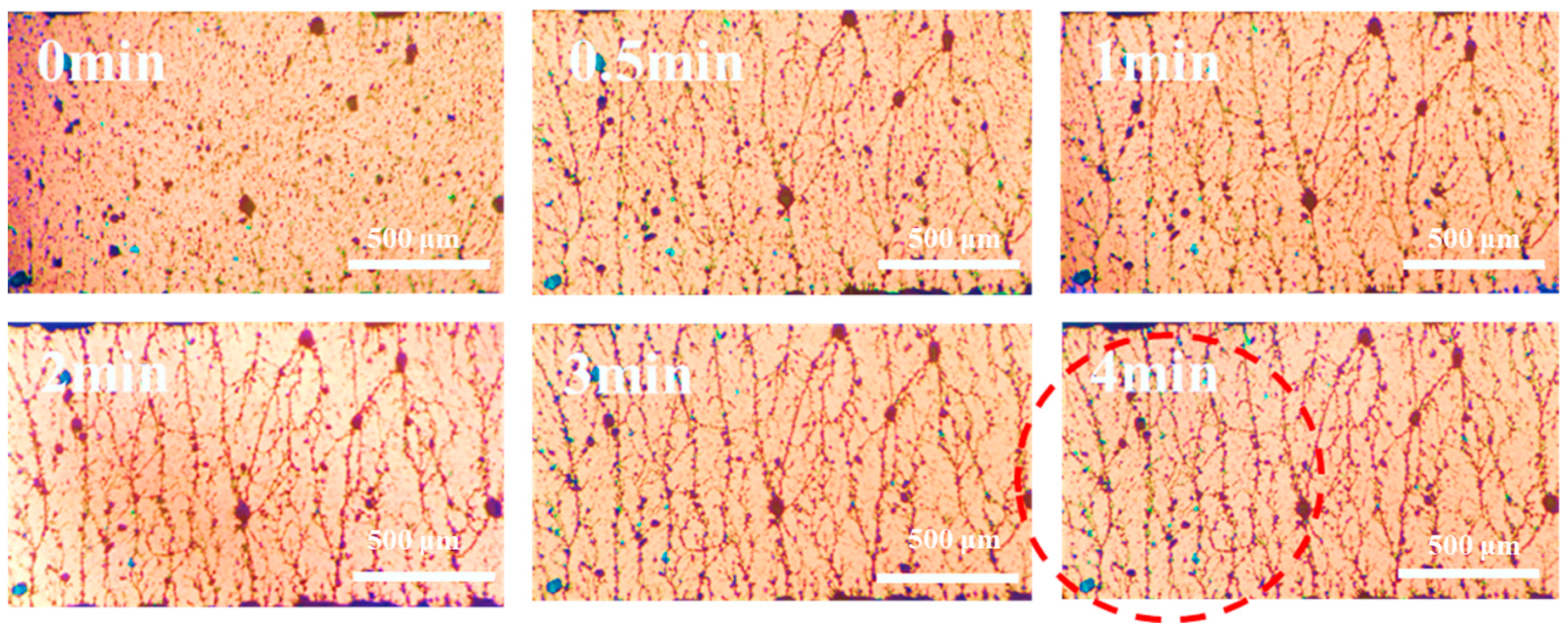

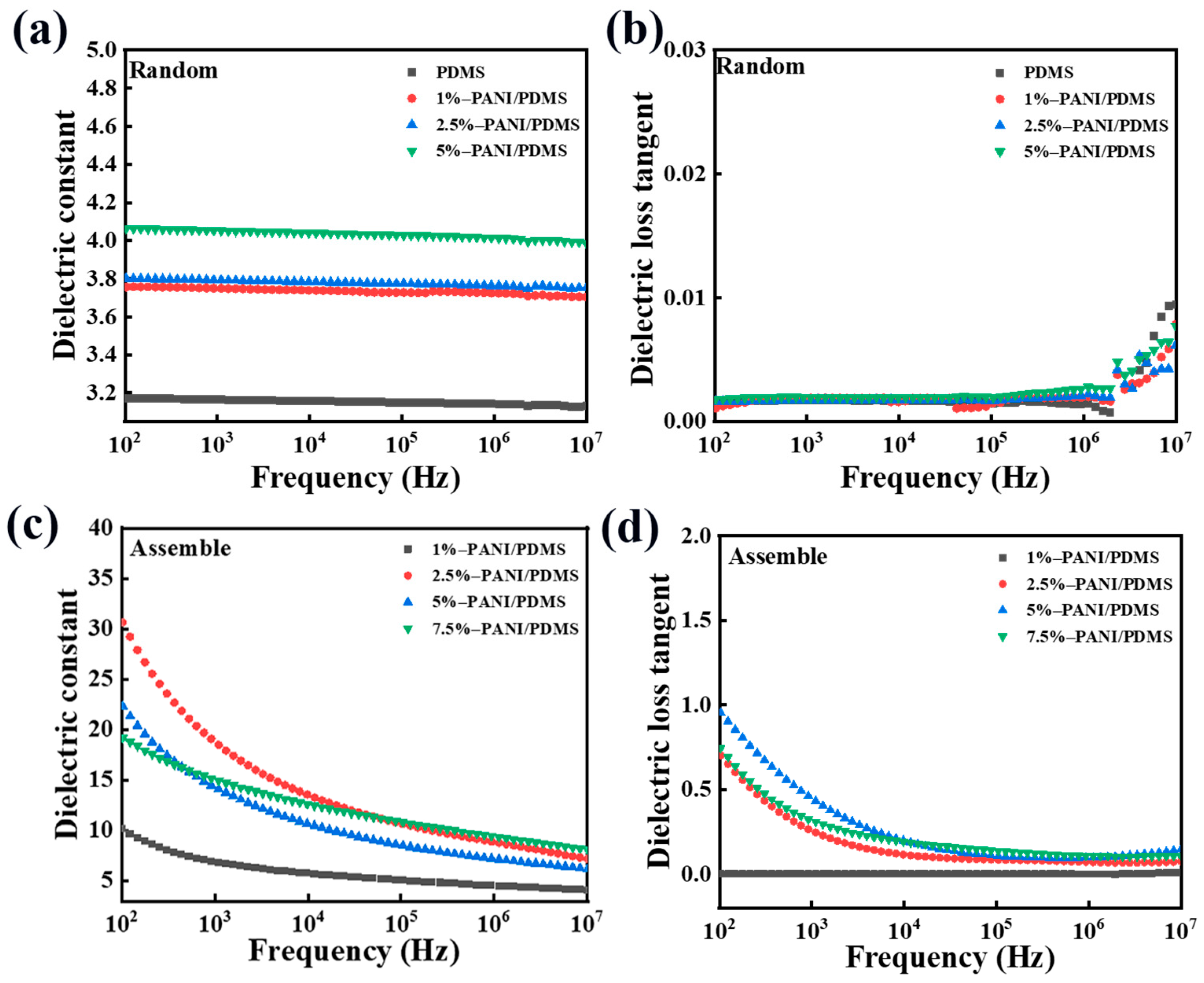

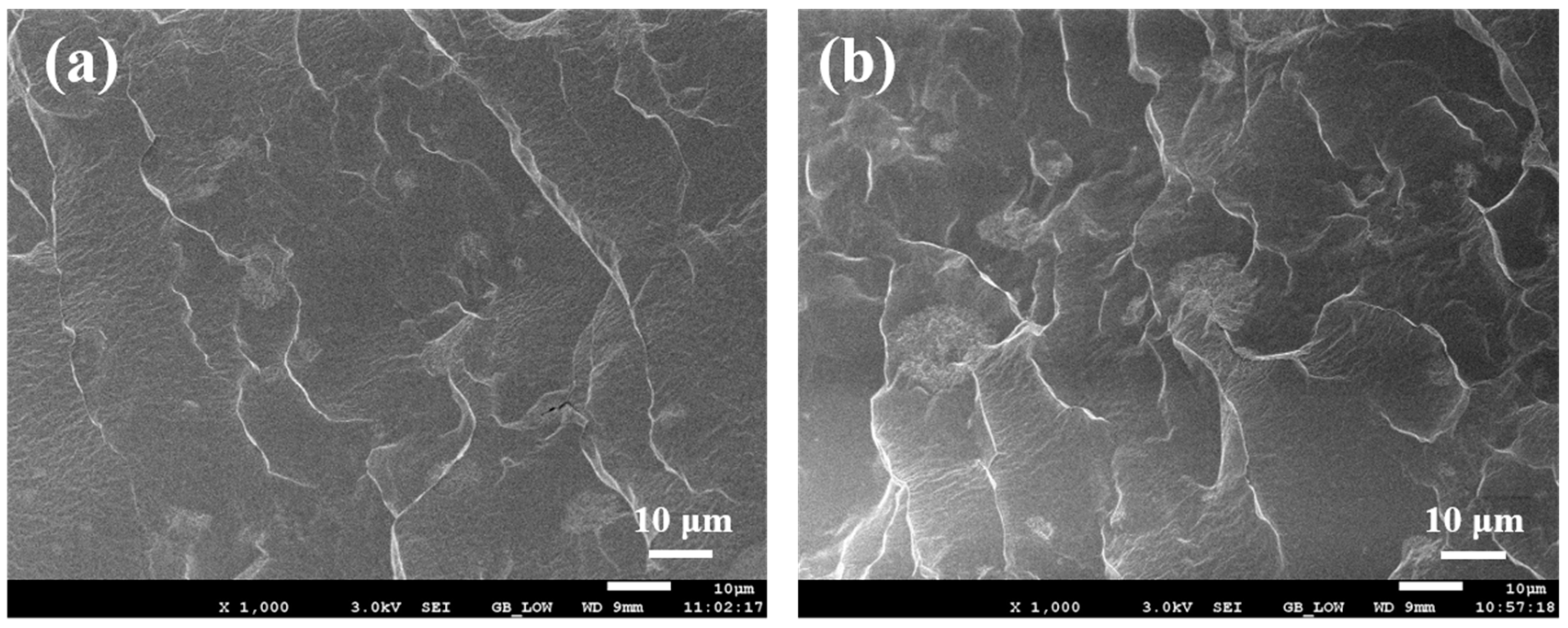

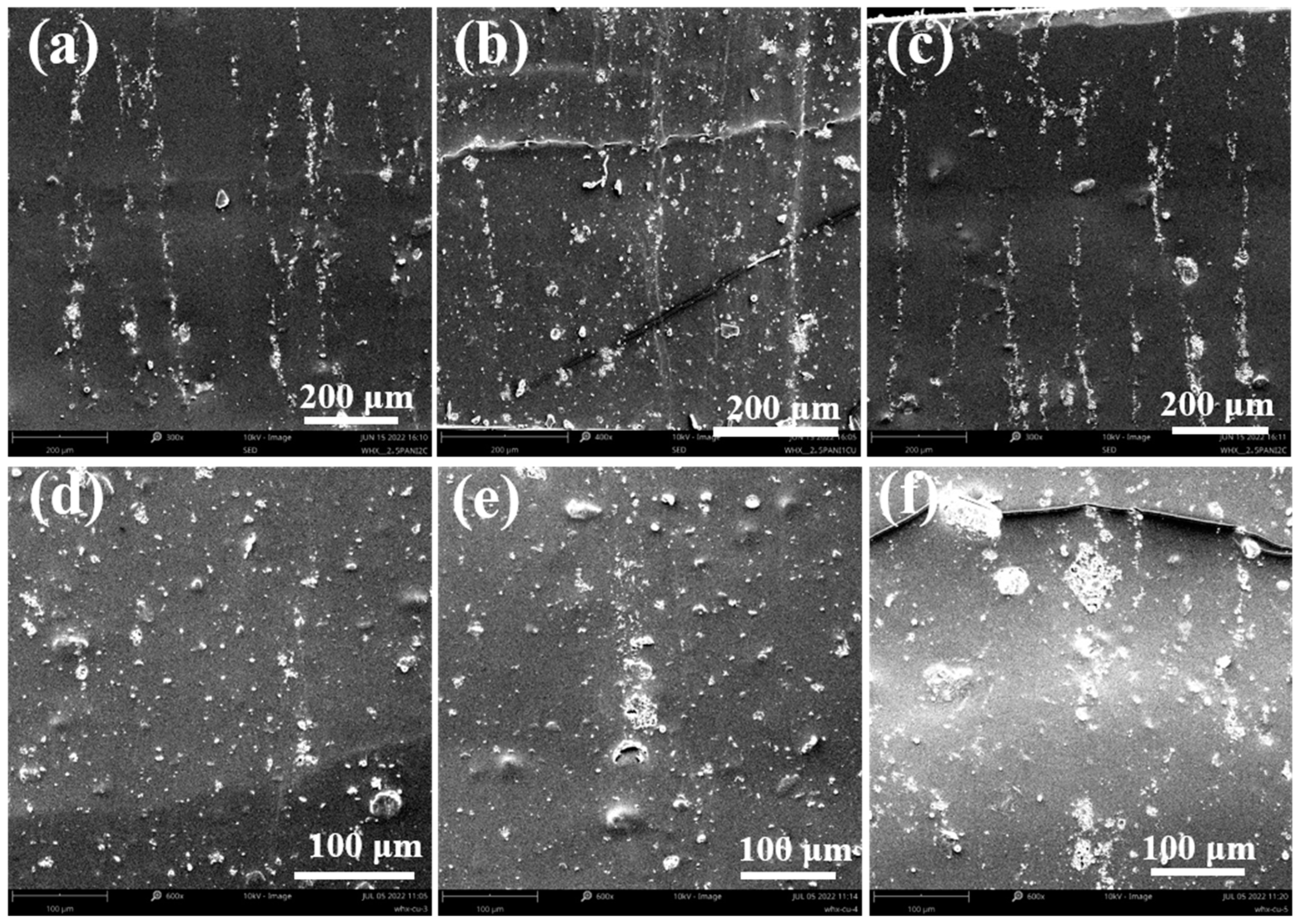
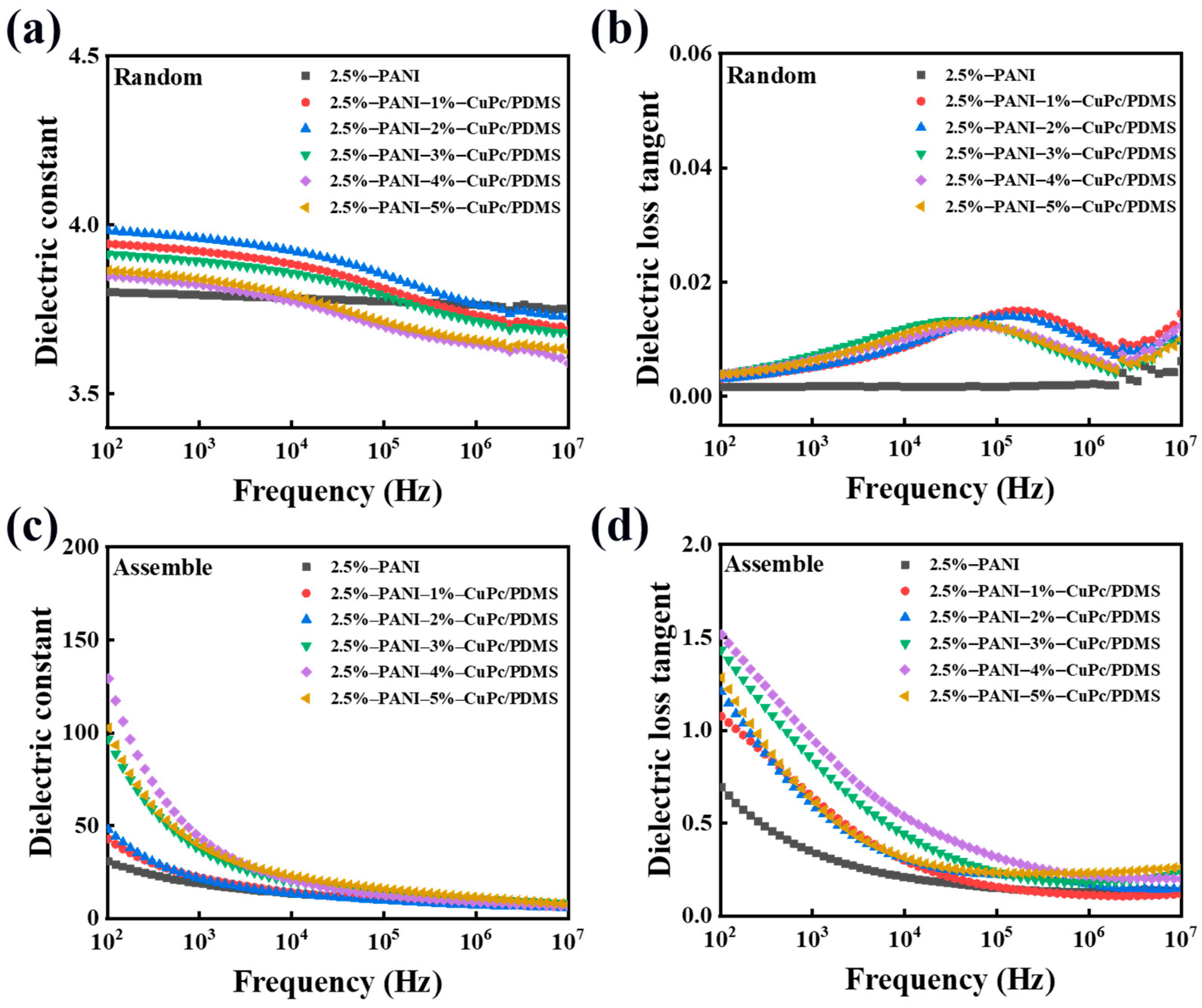



Disclaimer/Publisher’s Note: The statements, opinions and data contained in all publications are solely those of the individual author(s) and contributor(s) and not of MDPI and/or the editor(s). MDPI and/or the editor(s) disclaim responsibility for any injury to people or property resulting from any ideas, methods, instructions or products referred to in the content. |
© 2024 by the authors. Licensee MDPI, Basel, Switzerland. This article is an open access article distributed under the terms and conditions of the Creative Commons Attribution (CC BY) license (https://creativecommons.org/licenses/by/4.0/).
Share and Cite
Hu, J.; Chu, B.; Liu, X.; Wei, H.; Wang, J.; Kan, X.; Xia, Y.; Huang, S.; Chen, Y. Preparation of PANI/CuPc/PDMS Composite Elastomer with High Dielectric Constant and Low Modulus Assisted by Electric Fields. Polymers 2024, 16, 1549. https://doi.org/10.3390/polym16111549
Hu J, Chu B, Liu X, Wei H, Wang J, Kan X, Xia Y, Huang S, Chen Y. Preparation of PANI/CuPc/PDMS Composite Elastomer with High Dielectric Constant and Low Modulus Assisted by Electric Fields. Polymers. 2024; 16(11):1549. https://doi.org/10.3390/polym16111549
Chicago/Turabian StyleHu, Jinjin, Beizhi Chu, Xueqing Liu, Huaixiao Wei, Jianwen Wang, Xue Kan, Yumin Xia, Shuohan Huang, and Yuwei Chen. 2024. "Preparation of PANI/CuPc/PDMS Composite Elastomer with High Dielectric Constant and Low Modulus Assisted by Electric Fields" Polymers 16, no. 11: 1549. https://doi.org/10.3390/polym16111549





